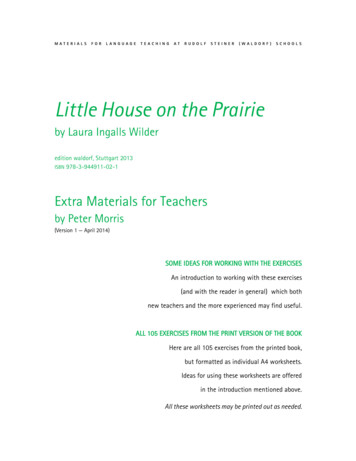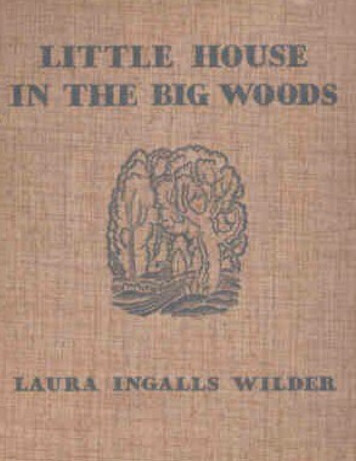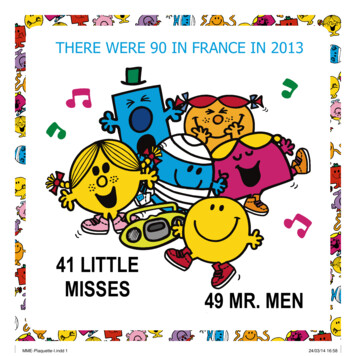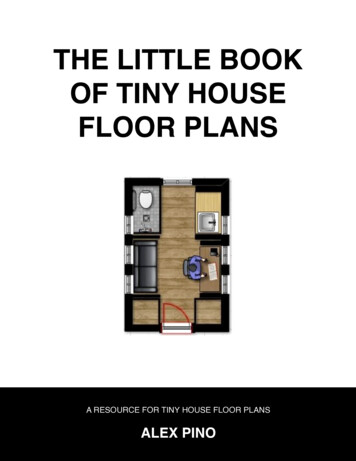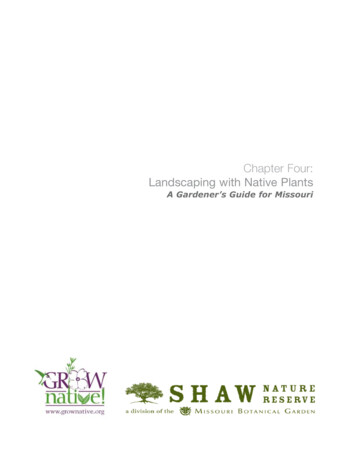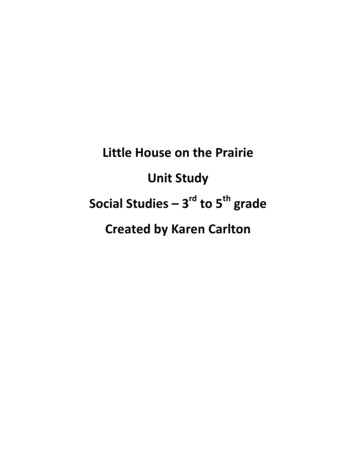
Transcription
Little House on the PrairieUnit StudySocial Studies – 3rd to 5th gradeCreated by Karen Carlton
The purpose of this unit study is help students learn aboutearly American history and be able to compare and contrast itto life today. They will be learning about the Midwest regionof the US and learning about pioneer life, it’s culture andcustoms, as well as the culture and customs of the NativeAmericans at the same time.This unit study was developed to use along with my readingunit (also on CIRCLE) and takes about 3 weeks to completeunless you are enjoying yourselves so much you need moretime!Key Learnings:1. Identify Native Peoples in the local area2. Explain how the local community was established and identifyfounders and early settlers3. Show how the Ten Commandments relate to the laws of a country4. Exhibit tolerance and respect for individuals with different beliefs5. Use a variety of maps6. Understand the importance of cooperation and sharing7. Know the impact of early settlers8. List the functions of money and compare and contrast things thathave been used as money in the state/parish/province9. Tell how natural resources affected the early settlers’ lives.10. Identify challenges of the different cultural groups throughout thehistory of the state/parish/province
Prairie dog videoLittle House on the PrairieSocial Studies Unit StudyCreated by Karen CarltonInternet Sources:http://www.youtube.com/watch?v jcB5kySUxWAPronhorn videohttp://www.youtube.com/watch?v Qdux3-cCj2IFiddle music & picturehttp://www.youtube.com/watch?v NGtckNUY7b8&feature results main&playnext 1&list PLF991E92B85E9FF9CSod House l/hult sod02.htmlLaura’s Travels map.jpgWolves videohttp://www.youtube.com/watch?v 20SWz2Gf BYhttp://www.youtube.com/watch?v UYSE5 cOh0w&feature related (this one is almost one hour long – you may want topick parts or pieces to show that are appropriate for our kids)
Matchbook foldable directions on page 244 of this 033750/anc/teachers rb 2.pdfBarn Raising videohttp://www.youtube.com/watch?v hmHbu2VC6UAhttp://www.youtube.com/watch?v 2H5tN8N3xac&feature relatedOsage airie mlTrail of s.htmlwww.brainpopjr.com you have to have a subscription here
Elementary Lesson PlanName: Karen CarltonSubject: Social StudiesTopic: Little House on the PrairieDate:Day 1Time:Grade Level: Third - FifthCONCEPT(S)/SKILL(S):To learn about Early American history and how it was different and/or the same as today.INSTRUCTIONAL OBJECTIVES:To learn about the Midwest region of the U. S. and to learn about pioneer life, it's cultureand customs as well as the culture and customs of the Native Americans at the same time.I.II.III.SET:A. Raising the Level of Concern: MotivationShow a map of the U. S. and point out the 5 major regions of the the country.B. Review/Prior KnowledgeWhat region do we live in? (k)What region is in the middle of the United States? (c)Did the Wilders stay in the same region when they moved from WI to KS? (app)How was the land different from the big woods to the prairie? (analysis)C. State ObjectiveWe are going to learn about some of the difficulties and good things that theIngalls family experienced.ACQUISITION:A. ExplanationRead first chapter of Little House on the Prarie. Teacher read aloud and studentsfollow along to look at the pictures.B. OrganizerPrepare a two column chart. First column entitled "Difficulties in the new place"and the second column entitled "Enjoyable things in the new place". Use thischart to note the differences between life in the big woods and life on the prairiein Indian territory.C. Structured PracticeBegin working on a poster that will describe the life and times of the Wilderfamily in America. Research and find info on one of the following questions.(All questions will be covered when the project is finished.)1. 2-5 events in Laura's family2. 3-5 events in US or world history3. A US President or First Lady fact. Who was it and something about them.4. An invention or technology item of the times.Divide the poster into four equal parts and use one part for each question. Labeleach section. Include at least 3 pictures for each section. (We will work on thisfor several days.)CONSOLIDATION:A. Guided Practice
Look at the chart and pick one thing that was difficult or different about theprairie. Draw a picture of that and write why you think that would be hard ordifferent. Share with the class.B. ClosureThere were many difficulties facing Pioneers that are easy things for us today.(Slow travel/cars, no maps, rest areas, hotels, restaurants, etc.) But it was also anexciting time because people were beginning to travel more and see new areas.C. Independent PracticeWrite in your journals three reasons why you would be excited to move like Lauraand explain why those things would be exciting. Title your entry "The Fun ofMoving".USE OF TECHNOLOGY/MATERIALS:Maps, poster boards, history books and internet for researching historical facts for theposters.
ToolsWeight in Poundsaxshovelhatchethammerhoeanvilgrinding stoneanimal traprope151297315075154Personal Items Weight in Poundsdolljump ropemarblesfamily Biblebookshunting knifebag of clothesfiddlesnowshoesriflepistolfirst aid kit21122140281073FoodWeight in Poundsflourteasaltsugarcoffeebacondried fruitdried beanscornmealspit peasoatmealvinegar1501050501004010010010100825
picklesdried beefsalt porkassorted spicesbarrel of watervegetables5025553505HouseholdGoodsWeight in Poundscoffee grinderrugbeddingmirrordutch ovenbutter churntable and 4 chairspianoorganbaby cradlewooden bucketbedpanbutter moldrocking chairpitcher and bowlcooking stovecooling utensilsstoolspinning wheellanternclock10 candlesset of his is the amount of food that was recommended for each person travelling West in acovered wagon.200 pounds of flour30 pounds of pilot bread (hardtack)75 pounds of bacon
10 pounds of rice5 pounds of coffee2 pounds of tea25 pounds of sugar½ bushel of dried beans1 bushel of dried fruit2 pounds of saleratus (baking soda)10 pounds of salt½ bushel of corn meal½ bushel of corn, parched and ground1 small keg of vinegar
Elementary Lesson PlanName: Karen CarltonSubject: Social StudiesTopic: Little House on the PrairieDate:Day 2Time:Grade Level: Third - FifthCONCEPT(S)/SKILL(S):To learn about Early American history and how it was different and/or the same as today.INSTRUCTIONAL OBJECTIVES:To learn about the Midwest region of the U. S. and to learn about pioneer life, it's cultureand customs as well as the culture and customs of the Native Americans at the same time.I.II.III.SET:A. Raising the Level of Concern: MotivationShow picture of inside of wagon again (from Reading yesterday). Talk about howsmall the space was.B. Review/Prior KnowledgeWhat kinds of things did the Ingalls family need to pack? (k)Did they take furniture? Why or why not? (analysis)Why did they have to chose and not just take everything? (app)Was it hard to decide what to take? (c)C. State ObjectiveWe are going to make our own list of things that we would need to start a newhome on the prairie.ACQUISITION:A. ExplanationGive students a list of possible items that they can take along. Explain what amanifest was and how it was used for packing.B. OrganizerMake a 2-column chart on poster board of "Needed Items" and "Wanted Items".Printed list will be large enough that the students can cut them apart and thenpaste them in the appropriate columns on their chart. The list of items has weightsas well, so students will need to make sure they don't "load" their wagon toheavily.C. Structured PracticeStudents will work in teams of two or three to make their charts and agree onwhich things are needed and wanted. They will be creating their own manifest forthe trip.CONSOLIDATION:A. Guided PracticeCompare manifests by presenting them to the class. Compare the manifests towhat most people usually took in their wagons.B. ClosureChoices were very difficult for the Pioneers. They had to leave their thingsbehind and their family and friends.C. Independent Practice
Think about one thing that the Wilders had to leave behind and write at least 5sentences in your journals about why that would have been hard to leave. Titlethe entry "Left Behind".USE OF TECHNOLOGY/MATERIALS:Picture of inside of wagon (from yesterday). List of common items to pack and whatthey typically packed.
Elementary Lesson PlanName: Karen CarltonSubject: Social StudiesTopic: Little House on the PrairieDate:Day 3Time:Grade Level: Third - FifthCONCEPT(S)/SKILL(S):To learn about Early American history and how it was different and/or the same as today.INSTRUCTIONAL OBJECTIVES:To learn about the Midwest region of the U. S. and to learn about pioneer life, it's cultureand customs as well as the culture and customs of the Native Americans at the same time.I.SET:A. Raising the Level of Concern: MotivationShow video clip about prairie dogs and other prairie animals.B. Review/Prior KnowledgeWhat kind of animals was Laura watching on the ground? (k)How do these animals live and survive on the prairie? (c)What other types of animals live on the prairie? Do any of these animals livehere? Do we live in the prairie? (appl)How are these animals different from animals that live in the mountains?(analysis)C. State ObjectiveWe are going to learn more about some of the animals that lived on the prairie.II.ACQUISITION:A. ExplanationRead to end of page 51.B. OrganizerMake a pocket book with the headings "Prairie Animals" and "MountainAnimals". Cut out pictures of animals for each pocket.C. Structured PracticeContinue working on a poster that will describe the life and times of the Wilderfamily in America. Research and find info on one of the following questions.(All questions will be covered when the project is finished.)1. 2-5 events in Laura's family2. 3-5 events in US or world history3. A US President or First Lady fact. Who was it and something about them.4. An invention or technology item of the times.Divide the poster into four equal parts and use one part for each question. Labeleach section. Include at least 3 pictures for each section. (We will work on thisfor several days.)III.CONSOLIDATION:A. Guided Practice
Look at your pocket book of animals. Which animal would you like to learn moreabout. Take 10 minutes to look up some more information about that animal andlist the things you find out in your journal titled "Prairie Animals".B. ClosureMany animals are the same now as they were during Laura's time, but someanimals are not as common today as they were then. (ie Buffalo)C. Independent PracticeWrite in your journals why you think we don't have as many animals in Iowa andthe Midwest Region now. Title your entry "Animals Today"USE OF TECHNOLOGY/MATERIALS:Maps, poster boards, history books and internet for researching historical facts for theposters. Prairie Animal Video. Pictures of animals from prairie and mountain areas.
Elementary Lesson PlanName: Karen CarltonSubject: Social StudiesTopic: Little House on the PrairieDate:Day 4Time:Grade Level: Third - FifthCONCEPT(S)/SKILL(S):To learn about Early American history and how it was different and/or the same as today.INSTRUCTIONAL OBJECTIVES:To learn about the Midwest region of the U. S. and to learn about pioneer life, it's cultureand customs as well as the culture and customs of the Native Americans at the same time.I.II.III.SET:A. Raising the Level of Concern: MotivationListen to a brief piece of fiddle music. Show a picture of a fiddle.B. Review/Prior KnowledgeWhat king of instrument was playing the music? (k)How is it like or unlike a violin? (c)What type of people play the fiddle and what type play the violin? (appl)Where would the different styles of music be played? Whay was a fiddleimportant on the prairie? (analysis)C. State ObjectiveWe are going to continue to learn about some things that were happening orimportant during Laura's time.ACQUISITION:A. ExplanationRead to end of page 70.B. OrganizerIn your journal make a list of at least 5 words or feelings that you think of whenyou listen to the fiddle music. (Play a jig and also a slower song while thechildren are thinking about this and making their list.)C. Structured PracticeContinue working on a poster that will describe the life and times of the Wilderfamily in America. Research and find info on one of the following questions.(All questions will be covered when the project is finished.)1. 2-5 events in Laura's family2. 3-5 events in US or world history3. A US President or First Lady fact. Who was it and something about them.4. An invention or technology item of the times.Divide the poster into four equal parts and use one part for each question. Labeleach section. Include at least 3 pictures for each section. (We will work on thisfor several days.)CONSOLIDATION:A. Guided PracticeShow a clip of a movie with a fiddle and jig dance.B. Closure
Today we can listen to music on the radio, cd player, movies, internet, concerts,etc. On the prairie the only music was singing, whistling or whatever instrumentsomeone had that they could play.C. Independent PracticeWrite in your journals about the kind of instrument you would like to play andwhat kind of music it would make. Would it be played by itself or play with otherinstruments in a band or orchestra. Title your entry "Music"USE OF TECHNOLOGY/MATERIALS:Maps, poster boards, history books and internet for researching historical facts for theposters. Fiddle music and pictures.
Elementary Lesson PlanName: Karen CarltonSubject: Social StudiesTopic: Little House on the PrairieDate:Day 5Time:Grade Level: Third - FifthCONCEPT(S)/SKILL(S):To learn about Early American history and how it was different and/or the same as today.INSTRUCTIONAL OBJECTIVES:To learn about the Midwest region of the U. S. and to learn about pioneer life, it's cultureand customs as well as the culture and customs of the Native Americans at the same time.I.II.III.SET:A. Raising the Level of Concern: MotivationShow a picture of a sod house. Explain that Laura and many pioneers lived in asod house for a while until they could build a "real" house.B. Review/Prior KnowledgeWhy did people build sod houses? (k)Where was a sod house built? (c)How would it feel to live in a sod house? (appl)How would a sod house be different from your house? (analysis)C. State ObjectiveWe are going to work on a map of where Laura and her family travelled.ACQUISITION:A. ExplanationRead to end of page 79.B. OrganizerGive each student a map of the midwest states with nothing written on them.C. Structured PracticeYou will need to look at a present day map to find where Laura and her familybegan their journey in the Big Woods of Wisconsin and map their trek toIndependence, Kansas. Labed each of the 5 states, the 2 rivers and 1 large town.CONSOLIDATION:A. Guided PracticeLook at pictures of log cabins - inside and outside. Compare them to our homestoday.B. ClosureToday we usually move into a house that is already built and ready with paint,carpet and walls and doors and windows. Laura's family came to a spot on theprairie and decided that they would build their own house right there. It took a lotof very hard work to get the house built.C. Independent PracticeBuild a log cabin out of sticks collected from the playgroud or from Lincoln Logs.USE OF TECHNOLOGY/MATERIALS:
Sod house & log cabin pictures. Map worksheet and maps for the children to look at.Lincoln logs or sticks to build with.
Elementary Lesson PlanName: Karen CarltonSubject: Social StudiesTopic: Little House on the PrairieDate:Day 6Time:Grade Level: Third - FifthCONCEPT(S)/SKILL(S):To learn about Early American history and how it was different and/or the same as today.INSTRUCTIONAL OBJECTIVES:To learn about the Midwest region of the U. S. and to learn about pioneer life, it's cultureand customs as well as the culture and customs of the Native Americans at the same time.I.II.III.SET:A. Raising the Level of Concern: MotivationListen to the sound of wolves howling on cd or internet.B. Review/Prior KnowledgeWhat kind of animal makes that sound? (k)Do wolves usually live by themselves or in groups? (c)Would wolves be a scary thing for someone living on the prairie? Why? (appl)What do wolves eat and why would this have worried the Ingalls family?(analysis)C. State ObjectiveWe are going to continue to learn about some things that were happening orimportant during Laura's time.ACQUISITION:A. ExplanationRead to end of page 98.B. OrganizerMake a shutter foldable and list all the things that you know about wolves inside.Label the top "What I know about Wolves". Students will interact with teacherand make a master list but each student will make their own list in their foldable.C. Structured PracticeContinue working on a poster that will describe the life and times of the Wilderfamily in America. Research and find info on one of the following questions.(All questions will be covered when the project is finished.)1. 2-5 events in Laura's family2. 3-5 events in US or world history3. A US President or First Lady fact. Who was it and something about them.4. An invention or technology item of the times.Divide the poster into four equal parts and use one part for each question. Labeleach section. Include at least 3 pictures for each section. (We will work on thisfor several days.)CONSOLIDATION:A. Guided PracticeShow a short video clip about wolves.B. Closure
Today we don't need to worry about wolves since they live in the mountains andnot out in our backyards. But wolves were a very real concern for people livingon the prairie.C. Independent PracticeWrite in your journals the five most interesting things you've learned aboutwolves. Title your entry "Wolves".USE OF TECHNOLOGY/MATERIALS:Wolf video, howling sounds cd/web. Shutter foldables.
Elementary Lesson PlanName: Karen CarltonSubject: Social StudiesTopic: Little House on the PrairieDate:Day 7Time:Grade Level: Third - FifthCONCEPT(S)/SKILL(S):To learn about Early American history and how it was different and/or the same as today.INSTRUCTIONAL OBJECTIVES:To learn about the Midwest region of the U. S. and to learn about pioneer life, it's cultureand customs as well as the culture and customs of the Native Americans at the same time.I.II.III.SET:A. Raising the Level of Concern: MotivationWatch a short clip from Little House on the Prairie TV Series to show the prairieand log cabin.B. Review/Prior KnowledgeHow did the Ingalls family get their food? (k)Was if difficult to keep food good? (no refrigeration, long ways from the store,etc) (c)How often do you go to the store? How often did Laura's family go to the store?(appl)Why didn't they go to the store more often? (analysis)C. State ObjectiveToday we are going to think about all the things that the Ingalls family needed.There weren't any Walmart's or grocery stores so they had to live off the land.(Food, shelter, safety, warmth, furniture, etc.)ACQUISITION:A. ExplanationRead to end of page 119.B. OrganizerMake a two column list of items that they used from the prairie in the first columnand what they were used for in the second column. (Example: wood - warmth,lumber for the house and barn, furniture, etc.)C. Structured PracticeFinish working on a poster that will describe the life and times of the Wilderfamily in America. Research and find info on one of the following questions.(All questions will be covered when the project is finished.)1. 2-5 events in Laura's family2. 3-5 events in US or world history3. A US President or First Lady fact. Who was it and something about them.4. An invention or technology item of the times.Divide the poster into four equal parts and use one part for each question. Labeleach section. Include at least 3 pictures for each section. (We will work on thisfor several days.)CONSOLIDATION:
A. Guided PracticeToday we will share the posters with the class. Each student will briefly tell theclass about the things they found out.B. ClosureOur lives today are much different from those of the pioneers. We have storeswhere we can buy almost anything we might ever think of wanting or needing.But the pioneers were happy and content with what they had. The didn't need asmany things as we do today because life was more simple.C. Independent PracticeThink about one thing that is different for your family and write in your journalhow Laura might react if she had that thing in her life. Would it have made herlife happier or more busy?USE OF TECHNOLOGY/MATERIALS:Little House on the Prairie video.
Elementary Lesson PlanName: Karen CarltonSubject: Social StudiesTopic: Little House on the PrairieDate:Day 8Time:Grade Level: Third - FifthCONCEPT(S)/SKILL(S):To learn about Early American history and how it was different and/or the same as today.INSTRUCTIONAL OBJECTIVES:To learn about the Midwest region of the U. S. and to learn about pioneer life, it's cultureand customs as well as the culture and customs of the Native Americans at the same time.I.II.III.SET:A. Raising the Level of Concern: MotivationShow several pictures of Native Americans.B. Review/Prior KnowledgeWhere did the Native American's live? (k)What did the pioneers know about Native Americans? (c)How did that effect the pioneer's thinking about whether the Indians were good orbad neighbors? (appl)Were the Native Americans enemies of the pioneers? (analysis)C. State ObjectiveToday we are going to learn some more about the Indians and how their liveswere effected by the pioneers coming to their land.ACQUISITION:A. ExplanationRead to end of page 146.B. OrganizerUse a matchbook foldable to make a list of facts you know about the Indians andthe Pioneers. One side will be for each group of people. Include what you knowabout the way they lived, what they ate, how they travelled, etc.C. Structured PracticeWe will work together on a master list of the facts that we know and then thestudents will transfer those items to their matchbook foldables.CONSOLIDATION:A. Guided PracticeToday we will share the posters with the class. Each student will briefly tell theclass about the things they found out.B. ClosureWhen the pioneers began moving into Indian territory, there was a lot ofmisunderstanding between the two groups of people. Today there are still somemisunderstandings between people who are different.C. Independent PracticeThink about something that might have been hard for the Indians when thepioneers started moving into their land. Write about what that was and how itaffected the Indian's way of living. Title your entry "Changes".
USE OF TECHNOLOGY/MATERIALS:Native American pictures. Matchbook foldables.
Elementary Lesson PlanName: Karen CarltonSubject: Social StudiesTopic: Little House on the PrairieDate:Day 9Time:Grade Level: Third - FifthCONCEPT(S)/SKILL(S):To learn about Early American history and how it was different and/or the same as today.INSTRUCTIONAL OBJECTIVES:To learn about the Midwest region of the U. S. and to learn about pioneer life, it's cultureand customs as well as the culture and customs of the Native Americans at the same time.I.II.III.SET:A. Raising the Level of Concern: MotivationLook at online pictures/videos of a barn raising and harvesting in the fall.B. Review/Prior KnowledgeHow did the people get their barn built and their crops harvested? (k)Could the pioneers do those things by themselves? (c)Would their fields still be harvested if they had done the work themselves? Didthey need their neighbors? (appl)What were the benefits of working together? (analysis)C. State ObjectivePart of living on the prairie included working together to get things done beforewinter, or working together to do things that a person couldn't do by themselves.ACQUISITION:A. ExplanationRead to end of page 161.B. OrganizerMake a webchart to list some of the things that the pioneers needed to do to worktoghether. Draw a picture of Laura's family in the center and then add things thatthey might have needed help with.C. Structured PracticeWe will work together on a master list of the facts that we know and then thestudents will transfer those items to their matchbook foldables.CONSOLIDATION:A. Guided PracticePut students in teams of two or three. Blindfold the first child. They will need tonavigate a maze of chairs/desks etc. The team mate will be the helper and help toguide the blindfolded person to the other end of the maze.B. ClosureSometimes there are things that we need help with or need to work together to getaccomplished.C. Independent PracticeDraw a picture of one of the things from your webchart that the Ingalls familywould have needed help with. Draw this in your journal and color it. Write aparagraph describing the need. Title your entry "Helping"
USE OF TECHNOLOGY/MATERIALS:Video/Photos of barnraising and harvesting. Web chart worksheet.
Compare Your home to a Pioneer Home. Day 10 Social StudiesNumber of RoomsSize of RoomsWalls (covered with)WindowsDoorsHeatingCooking (with what)Furniture (kitchen andliving room)Ingall’s HomeYour Home
Elementary Lesson PlanName: Karen CarltonSubject: Social StudiesTopic: Little House on the PrairieDate:Day10Time:Grade Level: Third - FifthCONCEPT(S)/SKILL(S):To learn about Early American history and how it was different and/or the same as today.INSTRUCTIONAL OBJECTIVES:To learn about the Midwest region of the U. S. and to learn about pioneer life, it's cultureand customs as well as the culture and customs of the Native Americans at the same time.I.II.III.SET:A. Raising the Level of Concern: MotivationShow a picture of a modern day house and compare it to a picture of a log cabin.Today we'll compare these two types of houses and see how they are the same andhow they are different.B. Review/Prior KnowledgeHow many rooms did a pioneer house have? (k)Would this be considered a small house or just normal - everyone had one likethis? (c)Would your family and all your stuff fit into a house like this? (appl)Why are houses bigger today than they were on the prairie? (analysis)C. State ObjectiveToday we'll compare these two types of houses and see how they are the same andhow they are different.ACQUISITION:A. ExplanationRead to end of page 171.B. OrganizerThree column comparison chart.C. Structured PracticeStudents will fill in the comparison chart comparing Ingall's home to their ownhome.CONSOLIDATION:A. Guided PracticeTogether, the class will go outside to find some things that can be used in theirown diorama of what Laura's house and yard looked like. Collect items like smallsticks, moss, dry grasses, pebbles, etc.B. ClosureWe have compared how different our houses are today compared to the houses ofpioneers. We're going to make a picture in a box of what we think Laura's houseand yard looked like.C. Independent PracticeStudents will each have a box and the materials collected earlier to begin workingon a diorama.
USE OF TECHNOLOGY/MATERIALS:Pictures of modern day houses and log cabins. Glue, boxes for dioramas, string or twine,misc. craft supplies.
Elementary Lesson PlanName: Karen CarltonSubject: Social StudiesTopic: Little House on the PrairieDate:Day 11Time:Grade Level: Third - FifthCONCEPT(S)/SKILL(S):To learn about Early American history and how it was different and/or the same as today.INSTRUCTIONAL OBJECTIVES:To learn about the Midwest region of the U. S. and to learn about pioneer life, it's cultureand customs as well as the culture and customs of the Native Americans at the same time.I.II.III.SET:A. Raising the Level of Concern: MotivationWe'll look at some 1800's pictures of Dr. offices.B. Review/Prior KnowledgeWhat happens when you get really sick? Where do you go? (k)Would this be the same as the place where the Ingalls family would go when theygot sick? (c)How would their doctor be different than yours? (appl)Why did a Dr. usually just have a room in his house for his office and not ahospital like today? (analysis)C. State ObjectiveToday we will learn some more about pioneer life. We'll learn what it was like tobe sick on the prairie and how the pioneers handled that.ACQUISITION:A. ExplanationRead to end of page 198.B. OrganizerAdd a new page to your Little House Comparison Booklet.C. Structured PracticeStudents will add a new page to their booklets entitled Health Care. They will listthe things available for the pioneer families and compare that to what's availablefor health care today.CONSOLIDATION:A. Guided PracticeContinue working on the diorama of what Laura's house and yard looked like.Collect more items like small sticks, moss, dry grasses, pebbles, etc if needed.B. ClosureThe Ingalls family all got very sick and Dr. Tan said it was because of eatingwatermelons. Pa seemed not to believe Dr. Tan and ate watermelon anyway.Today, because of science we know that just eating watermelon will not make yousick.C. Independent PracticeIn your journals, write why you think Dr. Tan though the watermelon made themsick. Title your entry "Sickness".
USE OF TECHNOLOGY/MATERIALS:1800's Dr. office pictures.
Elementary Lesson PlanName: Karen CarltonSubject: Social StudiesTopic: Little House on the PrairieDate:Day 12Time:Grade Level: Third - FifthCONCEPT(S)/SKILL(S):To learn about Early American history and how it was different and/or the same as today.INSTRUCTIONAL OBJECTIVES:To learn about the Midwest region of the U. S. and to learn about pioneer life, it's cultureand customs as well as the culture and customs of the Native Americans at the same time.I.II.III.SET:A. Raising the Level of Concern: MotivationOsage Indian PictureB
Little House on the Prairie . Unit Study . Social Studies – 3rd to 5th grade . Created by Karen Carlton . . books 2 hunting knife 1 bag of clothes 40 fiddle 2 snowshoes 8 rifle 10 pistol 7 first aid kit 3. Food Weight in Pounds flour 150 tea 10 salt 50 sugar 50 coffee 100 .

